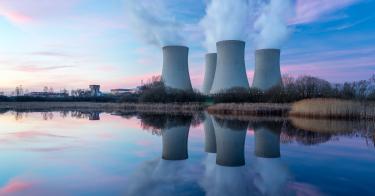We've all been there. Something breaks in your home or knocks your car bumper loose, so you turn to every American's trusted helper: duct tape. But while duct tape may offer an easier, quick-fix solution, it doesn't fully solve your problem, no matter how many new layers you slap on.
Similarly, the Trump administration is offering a duct-tape solution to bail out struggling coal and nuclear power plants. If you can even call it that – this particular bailout is an insult to the efficacy of duct tape.
A taxpayer- and ratepayer-funded lifeline may help certain plants in the short-term, but Congress and the administration should roll up their sleeves and address the real policy and regulatory issues contributing to coal and nuclear's economic woes.
In May 2018, a leaked draft memo from the Trump administration proposed executive actions to subsidize struggling coal and nuclear power plants. The administration claims that emergency intervention is necessary to prevent closures of "fuel secure" coal and nuclear power plants.
Even though grid experts have repeatedly affirmed that the grid is resilient and reliable, these plants, the administration argues, are necessary in the face of extraordinary threats – terrorism, extreme weather, cybersecurity and other "high-impact events."
More often than not, what the White House characterizes as looming national security crises are actually productive market signals that spur investment in new energy sources and innovation in competitive systems. For instance, increased abundant, reliable and inexpensive natural gas has caused many uncompetitive power generators to go out of business.
Many of the power plants at risk of early retirement are in the northeast region in competitive electricity markets. Most of them are in the PJM Interconnection, which serves 13 eastern states and the District of Columbia. PJM – whose sole responsibility is to maintain reliability in the markets under its jurisdiction – finds "no immediate threat to system reliability."
Good thing, too, because the Trump administration's bailout would be counterproductive to the long-term vitality of the coal and nuclear industries. Subsidies would discourage innovation and entrench government dependence. It would enable these industries to delude themselves that the federal government has solved the problem.
It's a predictable path of failure. The subsidies may spur some amount of commercial activity, but it's limited only to the amount subsidized. The failed nuclear renaissance is just one example.
The bailout also allows policymakers to ignore the systemic regulatory and policy problems that contribute to coal and nuclear's demise. Many policy problems do in fact contribute to the economic woes of new and existing coal and nuclear power plants. Both industries face the burdens of excessive, ineffective regulations and must compete against heavily subsidized alternative sources of energy. Coal and nuclear face profound politically-induced uncertainty in areas such as permitting, plant improvements, and technological innovation.
Unlike duct tape, however, the cost of the bailout to American households and businesses won't come cheap. A July 2018 report by the Brattle Group estimates the bailout would cost households and businesses $34 billion over a two-year period.
So what can Congress and the administration do? One practical solution would be to eliminate energy subsidies for all energy sources. Congress should ax direct expenditures, targeted tax breaks, mandates, loan guarantees and other preferential treatment that gives one technology an unfair price advantage over other ones.
Furthermore, regulatory overreach has increased costs to operate and upgrade existing plants. It has contributed heavily to the financial struggles of the coal and nuclear industries, but done little to nothing in the way of environmental benefits or improved safety. New, innovative small-scale coal and nuclear reactor technologies sit on the shelf because the current regulatory apparatus is unable to provide a timely and efficient license and permit.
The market should determine the fate of the coal and nuclear industries. The federal government should not attempt to prop them up. However, policymakers should not ignore all that has been done to increase the costs of building, supplying, and operating coal and nuclear power plants.
If the administration desires a strong coal and civilian nuclear industry for the long term, it must fix the underlying regulatory issues. Subsidizing plants only props up an industry temporarily, rather than fixing deep government-induced problems that would offer a real, long-term solution. Early plant closures should be a wakeup call to take concentrated action to accomplish these deep reforms.
This piece originally appeared in the Sacramento Bee




